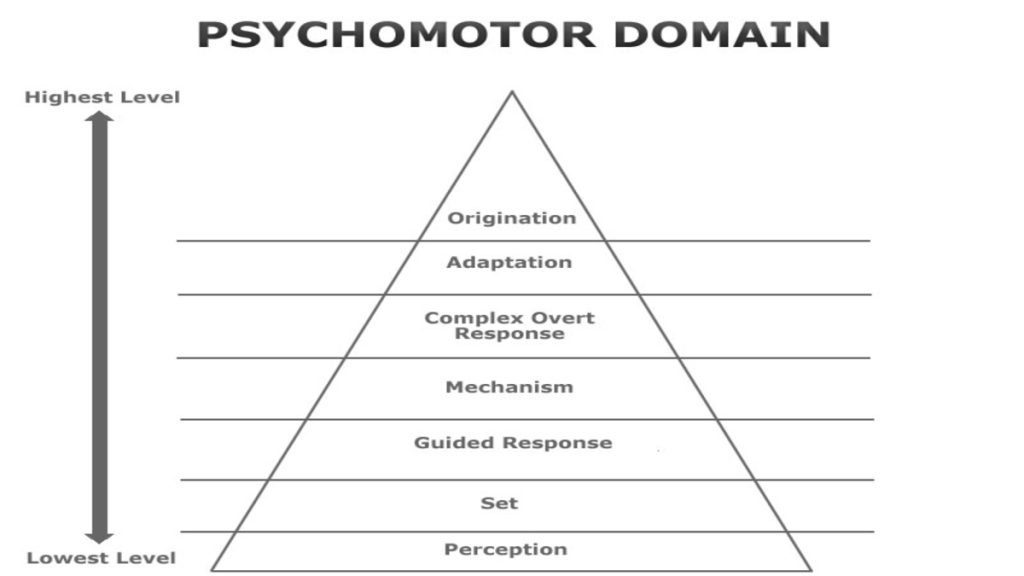Elizabeth Simpson’s taxonomy (1972) of psychomotor domain is based on the works of Bloom, Krathwohl and others. Simpson’s psychomotor domain focuses on utilizing motor skills and coordinating them. Her taxonomy emphasizes on the progression of mastery of a skill from observation to invention. The Harrow’s and Simpson’s psychomotor domains are especially useful for the development of children and young people, and for developing skills in adults that take people out of their comfort zones like. The Dave’s psychomotor domain is the simplest and generally easiest to apply in the corporate development environment. so it
Levels of Psychomotor Domain
The Simpson’s psychomotor domain (1972) includes physical movement, coordination, and use of the motor-skill areas. Development of these skills requires practice and is measured in terms of speed, precision, distance, procedures, or techniques in execution. Thus, psychomotor skills range from manual tasks, such as digging a ditch or washing a car, to more complex tasks, such as operating a complex piece of machinery or dancing.
The seven major categories from the simplest behavior to the most complex are listed as under;
1. Perception (Awareness)
Perception is the ability to use sensory cues to guide motor activity. This ranges from sensory stimulation, through cue selection, to translation. It requires the learner to demonstrate an awareness or knowledge of the behaviors needed to carry out the skill.
Key Words (Verbs) — Chooses, Describes, Detects, Differentiates, Distinguishes, Identifies, Isolates, Relates, Selects.
Examples (Learning Outcomes) — The learner; Detects non-verbal communication cues. Estimate where a ball will land after it is thrown and then moving to the correct location to catch the ball. Adjusts heat of stove to correct temperature by smell and taste of food.
2. Set (Mindset)
Set refers to the readiness to act. This is also called your mindset. It is the mental, physical and emotional dispositions that make you respond in a certain way to a situation. This subdivision of Psychomotor domain is closely related with the “Responding to phenomena” subdivision of the Affective domain.
Key Words (Verbs) — Begins, Displays, Explains, Moves, Proceeds, Reacts, Shows, States, Volunteers, Demonstrate, Assumes a position.
Examples (Learning Outcomes) — The learner; Shows desire to learn a new process (motivation). Recognizes one’s abilities and limitations. Knows and acts upon a sequence of steps in a manufacturing process.
3. Guided Response
Guided Response refers to the early stage of learning a complex skill. It is the first attempt at a physical skill and includes imitation, and trial and error. The learner can complete the steps involved in the skill as directed.
Key Words (Verbs) — Copies, Traces, Follows, Reacts, Reproduces, Responds, Attempts, Imitates, Tries.
Examples (Learning Outcomes) — The learner; Performs a mathematical equation as demonstrated. Follows instructions to build a model. Responds hand-signals of instructor while learning to operate a forklift.
4. Mechanism (Basic Proficiency)
This is the intermediate stage in learning a complex skill. It is the ability to convert the learned responses into habitual actions so the movements can be performed with a medium level of proficiency, assurance and confidence.
Key Words (Verbs) — Assembles, Calibrates, Constructs, Dismantles, Displays, Fastens, Fixes, Grinds, Heats, Manipulates, Measures, Mends, Mixes, Organizes, Sketches.
Examples (Learning Outcomes) — The learner; Uses a personal computer. Repairs a leaking faucet. Drives a car.
5. Complex Overt Response (Expert)
Complex Overt Response is the ability to skillfully perform complex movements correctly. Complex movements are performed quickly, accurately and with a minimum wasted effort. This category includes automatic and highly coordinated performance without hesitation.
Key Words (Verbs) — The key words are the same as Mechanism, but will have adverbs or adjectives that indicate that the performance is quicker, better, more accurate, etc. e.g. Calibrates accurately, Fastens tightly.
Examples (Learning Outcomes) — The learner; Maneuvers a car into a tight parallel parking spot. Operates a computer quickly and accurately. Displays competence while playing the piano.
6. Adaptation
Adaptation is the ability to modify the learned skills to meet new or special requirements. Your skills are so well developed that you can modify movement pattern to fit special requirements.
Key Words (Verbs) — Adapts, Alters, Changes, Rearranges, Reorganizes, Revises, Modifies, Varies.
Examples (Learning Outcomes) — The learner; Responds effectively to unexpected experiences. Modifies instruction to meet the needs of the learners. Performs a task with a machine that it was not originally intended to do (machine is not damaged and there is no danger in performing the new task).
7. Origination
Origination is the ability to create new movement for a special situation or problem. You are able to develop an original skill from a learned skill. In other words, learning outcomes emphasize creativity based upon highly developed skills.
Key Words (Verbs) — Arranges, Builds, Combines, Composes, Constructs, Creates, Designs, Initiate, Makes, Originates.
Examples (Learning Outcomes) — The learner; Composes a new symphony. Develops a new and comprehensive training program. Creates a new gymnastic routine.
References
Simpson, E. J. (1972). The classification of educational objectives in the psychomotor domain: The psychomotor domain. Vol. 3. Washington, DC: Gryphon House.
OTHER RELATED POSTS
